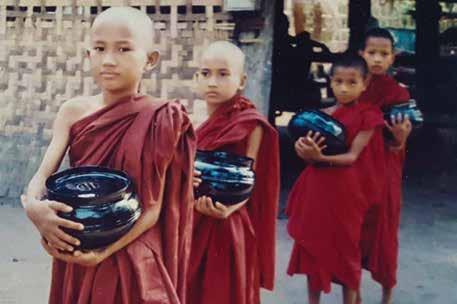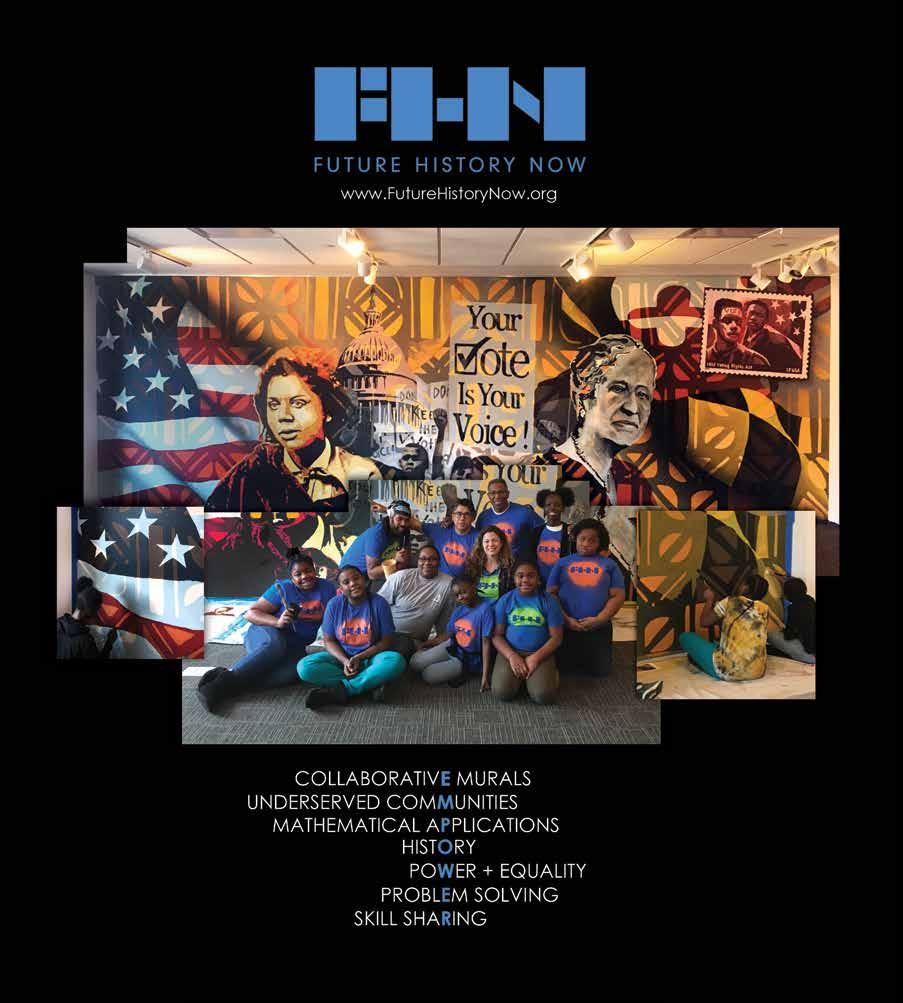
7 minute read
The Novice Monk
Zaw Maw leads a group in Vipassanā, a Buddhism-based meditation practice, during a Saturday afternoon seminar at The Commons in Annapolis.

Advertisement
rode into town on a horse, dressed as a prince, lavishing gifts of food upon the townspeople, wearing a bejeweled wooden crown, with shapes painted on his face with white paste ground from thanakha tree bark.
Maw remembers his rigid daily schedule at the sangha. He would awaken at 3 a.m. and drape his saffron robe around his body, pulling it through the string tied Shaving the scalp symbolized rejection of self and place in a world of material comforts and an entrance into the immaterial one. Stripped of his worldly station and possessions for the threemonth spiritual immersion, Maw experienced a strict Buddhist lifestyle—no home-cooked meals, visits with friends, or soccer playing on the monastery grounds. The day before his head was shaved, he around his waist. The string had to stay on his body, even when the saffron robe was not, as it was a reminder of his devotion to the Buddha. He would meditate for an hour before breakfast, then walk the village path through the green countryside with the other koyin. In his mind’s eye he can still see the blanket of morning fog covering the hills and hear the sound of roosters crowing.
Each boy carried a black lacquer bowl to collect the daily alms of food from the townspeople, and a tin cup for the curry. When they walked, they set their gaze just far enough ahead to know where they were going, and certainly not down at their feet. They were not to make eye contact with the people or say “thank you” to the givers. There was to be no emotional attachment to the exchange.
Such restrictions would give any teenager a reason to cry, but that was not the only reason for Maw’s tears. He feared the impending silence. “I was scared of what my mind would be like in the quietness because I don’t have any stimulation anymore,” he says, 19 years later. “What do I dwell on?” Perhaps this sharp memory is what allows Maw to empathize with his Annapolis Mindfulness students, some of whom are new to meditation.
A handful of people have come to the Sunday night group. Maw offers them herbal tea before starting. They initially sit in a circle, on white, plastic chairs, and listen as Maw offers suggestions on how to meditate, noting that there is more than one way. He tells them to focus on the cool sensation of the in-breath as it grazes the tip of the nose and then to focus on the warmth of the breath leaving the body. Observe the breath, he says, don’t try to change it, and do not judge it. After the brief practice, Maw invites the group to share what they experienced. He considers himself a novice still and learns from listening to others. Everything can be a meditation, says Maw. He meditates in silence a few times every day and while doing his daily activities. Cooking a curry can be a meditation, as can be his three-mile run or walking with his wife, Melissa, and their two-year-old daughter, Thida. Annapolis Mindfulness was born out of Maw’s passion for learning and for his culture. “I wanted to create a space where there’s going to be a discussion, but what’s going to be the subject?” he’d asked himself. “And that’s when it came about, what I’m passionate about: Buddhism.” Social worker Cary Lukens, 44, took Maw’s four-week beginner’s meditation course and says Maw puts the class at ease. “His teaching is unique, but it’s also very accessible,” says Lukens. “He’s a very gentle teacher.”
Students sit however they are comfortable, on floor pillows, chairs, or a couch. Maw shares teachings on Vipassanā meditation, or insight meditation, the practice of remaining present in mind and body.
Maggie O’Leary, 64, has been involved with Annapolis Mindfulness since its inception. She describes Maw as soft-spoken, nonjudgmental, and very deep. “I wanted to experience group meditation, and what it was like to actually learn meditation from somebody who had been trained as a Buddhist monk,” she says.
During the week, Maw works the late shift for the county’s crisis response system. If someone walks into a fire station or safe station asking for help with an addiction or a mental health emergency,

Courtesy of the Zaw Maw family archive.

Zaw Maw is passing on what he learned from his teachers. Maw shows up to care for the person’s immediate basic needs and follows that person’s progress.
Five years sober himself, Maw experienced two hospitalizations for emotional breakdowns. At age 21, Maw came to St. John’s College in Santa Fe, New Mexico, to study philosophy. During his first year, he found the mountain of cultural differences too high to scale. A debilitating homesickness crept in, and he sought an escape through alcohol. He withdrew from school in his sophomore year, only to experience a reverse culture shock upon his return home. Suspended between two worlds, the conservative mores of his Buddhist community and the expressive, secular American college community, “I lost my identity,” he explains.
During his mid-twenties, Maw remembers being frustrated and so consumed by what he calls selfcentered thoughts that he was not able to access his meditation practice. “Although the tool was available, I [couldn’t] see it,” he says. Amid the tumult, he decided to finish his education and came back to the United States, this time to St. John’s in Annapolis. His addiction and emotional struggles continued, and he suffered another emotional collapse.
Neil Fennerty (left) and Carman Klassen (right) join Zaw Maw in a group meditation.

In hindsight, he values that experience and sees how it has aided his spiritual growth. “I can contemplate on it in a meditation practice—what it means to be in the thought as opposed to with the thought,” he says. Since becoming sober, he got married and started a family. He graduates from St. John’s this spring and hopes to continue growing Annapolis Mindfulness. Maw ends each Sunday night session with a loving-kindness meditation. He instructs the group to meditate on the concentric circles of relationships in their lives, starting with those closest to them, wishing them health and happiness and that they be free from anger and free from danger. Next, they are to wish loving-kindness to their neighbors, then enlarge the circle to include the people in the city, then in the state, sending ripples of loving kindness as far as their minds can reach. After the five-minute closing meditation ends, there is a lighter feeling in the room. The group gets up to leave. Some have one more cup of tea and chat with Maw, each perhaps feeling a little more present than when they first arrived. They gather blankets and purses and put the chairs back around a table. Some walk together down the stairs and out onto West Street. Then they walk back to their cars, not looking too far ahead, and certainly not down at their feet. █
For more information, visit www.annapolismindfulness.com.

C O M E O N B Y ! JOIN US FOR
SUMMER CAMPS MIXED MEDIA + STREET ART + MOSAICS + DRAWING + MORE
artfarmannapolis.com
111 CHINQUAPIN ROUND RD. SUITE 200, ANNAPOLIS, MD MONTHLY ADULT WORKSHOPS + KIDS SEMESTER STARTS APRIL 20 SPRING CLASSES
GALLERY OPENING RECEPTION (PARTIES) EVERY OTHER MONTH GALLERY SHOWS

FOR YOUR NEXT PRIVATE EVENT OR WORKSHOP SPACE RENTALS


Annapolis We’re the
Arts District
WE’RE YOUR DIVERSE ARTS & ENTERTAINMENT DESTINATION
The Inner West Street Association is a 501(c)6 nonprofit organization The Annapolis Arts & Entertainment District is a 501(c)3 nonprofit organization
The Annapolis Arts District is comprised of unique venues, bars, and restaurants with local artists experienced in an array of media. Experience Annapolis from the flip side of the looking glass – from Westgate Circle to Church Circle, with a few spots in between!
El Distrito de las Artes en Annapolis está compuesto por lugares únicos, bares y restaurantes con artistas locales y experimentados en una gran variedad de medios. Vive Annapolis del otro lado del espejo, entre Westgate Circle y Church Circle, con algunos lugares intermedios!








